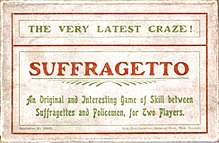Suffragetto
Suffragetto is a board game for two people. It appeared in May 1908. It was developed and marketed by the Women's Social and Political Union to promote their fight for women's suffrage . The theme of the strategy game is a fight between suffragettes and police officers .
history
The Women's Social and Political Union developed the game as a new way of fundraising . The organization, which was otherwise dependent on donations, tried around this time to create another financial pillar for itself by selling products. The company Sargeant Bros. Ltd. made the game.
The only known original copy is kept in the Bodleian Libraries of the University of Oxford .
Game idea
The suffragettes hold a conference at Albert Hall , London . From there they want to try to storm the House of Commons . To do this, they have to break through the closed line of police officers guarding the building. At the same time, they must prevent the police officers from occupying the location of their conference. Both sides have to avoid going to jail (suffragettes) or hospital (police officers).
Rules of the game
The game is played on a game board with 17 ✕ 17 fields. The middle area of the playing field of 9 ✕ 17 fields is colored pink and marked as "arena". On both sides of the playing field, 21 fields are marked as “prison” (with six additional fields as “prison yard”) or “hospital” (with six additional fields as “hospital area”).
Each side plays with 21 pieces, including 5 larger and 16 smaller ones. The dark blue tokens symbolize the police, the green tokens represent the suffragettes. At the beginning of the game, the pawns are placed on the fields marked with "S" or "P". The larger blue pawns are inspectors , the larger green pawns are the leaders of the suffragettes. The five large pawns are in the middle of the first row and on the four outermost squares of the first and second rows. The figures stand in front of and next to an area made up of six fields, which is called the “House of Commons” on the policemen's side and “Albert Hall” on the suffragette's side. The "House of Commons" is the target field of the suffragettes; the "Albert Hall" the target field of the police officers. The aim of the game is to completely occupy the respective target field.
Both sides take turns to move. On each turn a pawn may be moved either by pulling or jumping. When moving, the pawn is moved in any direction (also backwards and diagonally) onto an adjacent, unoccupied space. The six fields that serve as a target for the other side, as well as the fields marked as “Hospital” and “Prison” and their courtyards may not be entered or skipped. When jumping, you can jump over both your own and your opponent's pieces, but not more than one on consecutive fields. Any number of your own or opposing pieces can be skipped one after the other in one turn, provided there is a free space between them. Jumping is also allowed in all directions.
Pieces that are in the "arena" are captured by opposing pieces when they jump over. Suffragettes and simple policemen (small pawns) can only capture opposing pawns on diagonal moves; the leaders of the suffragettes and the police inspectors (large pawns) can hit pawns in any direction. Several pieces can be captured in one turn. Beaten suffragettes are put in "jail", beaten police officers in "hospital". If there are twelve or more pawns in the “prison” and in the “hospital”, each side may request an exchange of up to six pawns. The same number of figures from each side can participate in the game again, whereby the figures exchanged for each other must correspond to one another in “rank” (ie in size). They are placed in the forecourt of the "prison" or "hospital" and are allowed to move freely from there. As long as one or more figures are in one of the courtyards, no new exchange can be requested.
When a figure has reached one of its six target spaces, it may continue to move within this area, but cannot leave it again. The winner is whoever has occupied all six fields of the respective target field with his own pawns first.
Web links
- Suffragetto in the board game database BoardGameGeek (English)
- Suffragetto on gamesboard.org.uk (English; with photos of the instructions)
- Suffragetto. Physical Feminism in Edwardian Game , project of the Digital Media program of the Georgia Institute of Technology , April 2016, accessed on September 1, 2018 (English; with print template of the game plan)
- Suffragetto: How a board game helped women win the vote , BBC , March 8, 2018 (English)
literature
- Elizabeth Crawford: The Women's Suffrage Movement. A Reference Guide 1866-1928. Routledge, London 2000, ISBN 978-0-4152-3926-4 , pp. 235-236.
Individual evidence
- ^ Suffragetto: How a board game helped women win the vote. In: BBC . March 8, 2018, accessed September 1, 2018 .
- ↑ Elizabeth Crawford: The Women's Suffrage Movement. A Reference Guide 1866-1928. , P. 235.
- ↑ a b Suffragetto at gamesboard.org.uk (English), accessed on September 1, 2018.

